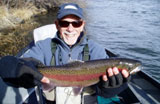|

Yong Special |
Materials:
|
|
Hook:
|
Targus or Tiemco 200R, Daiichi 1260, or similar
hook, sizes 20-24; for those who prefer a
straight shank hook, a standard dry fly hook
such as a Targus or Tiemco 100 will work
well.
|
|
Thread
for Head: |
8/0 (70 denier) black
|
|
Thread
for
Abdomen:
|
Coates & Clark sewing thread, Summer
Brown, #54A or Olive, #164B |
|
|
Description
Andy Kim, whose real name in Korean is Andy
Yong, is known as the legend of the San Juan
River. I’ve never met him; rather, I learned
of him through my friend Keith Kaneko who
has fished with him several times. Keith
uses the Yong Special wherever midges are
present, including the lower Yuba River
where he guides regularly. According to
Keith, the Yong Special will catch fish when
no other fly will work—and it out-fishes all
of the other midge patterns that we know and
love.
Here’s a testimonial: “Simple
but deadly. That's the best way to describe
Andy Kim's series of midge imitations. His
flies are so efficient, he has earned the
jealousy of some rival guides, and it was
long rumored on the San Juan River that he
must be scenting his flies, or somehow
fishing unethically. ‘How else can he catch
that many fish?’ anglers would whisper over
a beer at the Sportsman's Inn. ‘It's just
not natural.’”
http://www.mlsff.org/cgi-bin/Patterns/Recipes/F85/Yong_Special.pdf
Indeed, this fly is the ultimate in
simplicity—it’s all thread. It is the manner
of applying the thread that makes the
difference. It is critical that the finished
body be smooth, with no lumps. To accomplish
this, a smooth, tapered under body must be
laid down. This is done by unwinding the
thread so that it lies flat on the hook
shank. When the tapered under body is
completed, the thread is “over-tightened” by
spinning the bobbin clockwise; the taut
thread is then wound forward to create a
segmented body.
Thread type and color are also critical.
Andy Kim uses Coates and Clark sewing thread
for the body, and standard thread for the
head. Once the techniques are learned, it is
possible to tie several dozen specimens in
an hour.
(The following was taken from
http://prairiegoat.com/Fishing/FlyPatterns/YongSpecial.htm):
Tying Instructions
(Note: click Ctrl+ about 6 times to
enlarge the webpage & see photo
detail; Ctrl– 6 times to reduce
size)
|
|
1. Debarb the hook.
2. Attach
the thread at the mid-point of the
hook and unwind it by twisting the
bobbin counter-clockwise. Hold the
thread taut with your left hand
while taking two or three wraps
toward the eye of the hook. Leave
space for about two thread wraps
behind the hook eye to build a head
later. (Note: although the
following pictures don’t show the
thread untwisted, I highly recommend
that you do so; it will create a
smoother under body)
|
 |
|
|
|
|
3. Wrap
the thread back over the previous layer to
the mid-point of the hook and trim the
excess thread. This will help create the
tapered body of the fly. |
 |
|
|
|
|
4. Continue
to wrap thread to the rear of the hook and
stop just above the hook barb.
|
 |
|
|
|
|
5. Twist
the thread clockwise until it is tightly
wound. Wrap forward with touching turns to
the eye of the hook and make a small two
turn whip-finish. Trim the thread.
|
 |
|
|
|
|
6. Attach
the black 8/0 fly tying thread
behind the eye of the hook, and
build a pronounced head, or thorax,
that is a little less than ¼ the
length of the hook shank.
Whip-finish and apply a tiny drop of
super glue just behind the hook eye. |
 |
|
|
|
|
Finished
fly. |
 |
|
|
|
|
Tying
& Fishing Tips
1. As mentioned
in last month’s column, it is much easier to debarb the hook at the vise than on
the stream. If you drop the tiny hook at the bench you have a fighting chance to
find it; not so if you drop your fly while on the stream either when you are
trying to extract it from the fly box or while tying it on.
2. As also
mentioned in last month’s column, after using super glue to finish the fly, use
a piece of fine copper wire to ream out the eye. It will be hard enough to tie
this miniscule critter to your leader, but you’ll become totally frustrated if
you discover the tiny eye clogged as you try to poke the leader into the eye.
3. Fish the Yong
Special under an indicator if you wish, or use swinging techniques with an
intermediate line and a 9 or 10 foot leader tapered to 5x or 6x diameter.
4. I found the C
& C Summer Brown #54A thread at JoAnne’s craft store. Unfortunately all they had
was the large spool, so I had to have a friend with a sewing machine “decant” it
down to a sewing machine bobbin that fits my Renzetti midge bobbin (which is not
a bad thing when tying tiny flies).
Stay warm out there… |
|
|
|
|
 |
|

